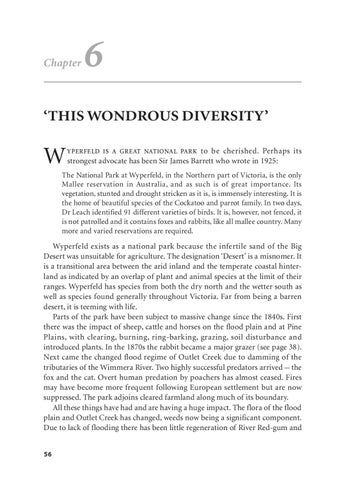Chapter
6
‘THIS WONDROUS DIVERSITY’
W
YPERFELD IS A GREAT NATIONAL PARK
to be cherished. Perhaps its strongest advocate has been Sir James Barrett who wrote in 1925:
The National Park at Wyperfeld, in the Northern part of Victoria, is the only Mallee reservation in Australia, and as such is of great importance. Its vegetation, stunted and drought stricken as it is, is immensely interesting. It is the home of beautiful species of the Cockatoo and parrot family. In two days, Dr Leach identified 91 different varieties of birds. It is, however, not fenced, it is not patrolled and it contains foxes and rabbits, like all mallee country. Many more and varied reservations are required.
Wyperfeld exists as a national park because the infertile sand of the Big Desert was unsuitable for agriculture. The designation ‘Desert’ is a misnomer. It is a transitional area between the arid inland and the temperate coastal hinterland as indicated by an overlap of plant and animal species at the limit of their ranges. Wyperfeld has species from both the dry north and the wetter south as well as species found generally throughout Victoria. Far from being a barren desert, it is teeming with life. Parts of the park have been subject to massive change since the 1840s. First there was the impact of sheep, cattle and horses on the flood plain and at Pine Plains, with clearing, burning, ring-barking, grazing, soil disturbance and introduced plants. In the 1870s the rabbit became a major grazer (see page 38). Next came the changed flood regime of Outlet Creek due to damming of the tributaries of the Wimmera River. Two highly successful predators arrived — the fox and the cat. Overt human predation by poachers has almost ceased. Fires may have become more frequent following European settlement but are now suppressed. The park adjoins cleared farmland along much of its boundary. All these things have had and are having a huge impact. The flora of the flood plain and Outlet Creek has changed, weeds now being a significant component. Due to lack of flooding there has been little regeneration of River Red-gum and
